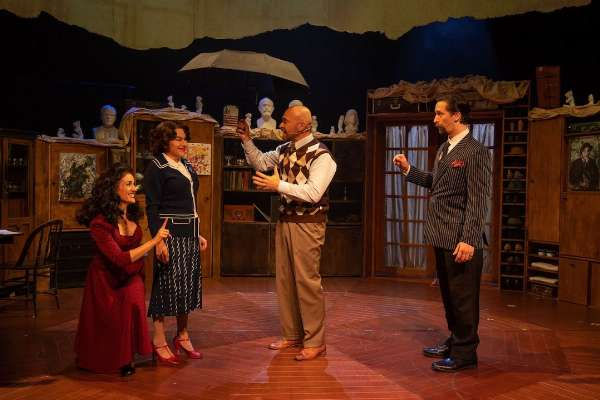Review: Driftwood The Musical at Glen Street Theatre
- Theatre Travels

- May 26, 2023
- 3 min read
Review by Bella Wellstead
Vienna, Austria, in the 1930s. The warm embrace of a cluttered little flat inhabited by a gaggle of struggling artists. A family flung across continents by the cruelty of the holocaust. Uncertainty, survival, love, healing, and the first ever foldable umbrella. Based on Eva de Jong-Duldig’s memoir, written by Jane Bodie, and directed by Gary Abrahams, Driftwood The Musical follows the Duldig family as they flee their native Austria. They grapple with their new life in Australia, isolated from so many of the people they love.
The show’s music – written by Anthony Barnhill – is amply infused with devotion, loss, and longing. The voices of the ensemble meld together beautifully, heightening the sadness of the Duldigs’ displacement with their haunting harmonies. The band, led by director David Gardos, is magnificent. Violinist Michele O’Young and cellist Rachel Valentine’s yearning melodies complement the mournful affect that meanders throughout the show.
Tania de Jong plays her grandmother Slawa with practicality and equilibrium. Here is a woman who is steadfast in her values and anxious for the safety of her family. A woman who silences her own suffering for the sake of her daughter’s wellbeing.
Bridget Costello performs as Slawa’s daughter Eva, seamlessly transforming and maturing throughout the play. Beginning at a newly-minted eighteen years old, Eva is sprightly and contrary, full to bursting with affection for her father, and nagged by the sense that her parents are not telling her something. Costello elegantly glides between Eva’s late teens and middle age, becoming more passionate as she uncovers her parents’ story and comes to terms with the loss of their past.
Anton Berezin’s Karl – Eva’s father – has a friendly, patriarchal impertinence. Berezin shines in scenes with Costello, where he effortlessly builds familiarity and rapport. His patient enthusiasm endears us to he and Eva both. One comes to love Eva – in all her pesky curiosity – through the eyes of her doting father.
Michaela Burger is graceful and self-assured as Rella, providing a clever counterpart to Slawa’s creative introspection. Burgers warmth, enthusiasm, and energy sparkle onstage, bursting with familial and convivial spirit.
Particularly delightful is Michaela Burger’s performance of ‘So Much To Tell You’ – a heartwarming musical number that chronicles Rella and Slawa’s reconnection after years of lost letters. Sophie Loughran’s choreography shines as Burger, de Jong, and Costello twirl across the stage in a flurry of envelopes passed from actor to actor. Burger is pitch-perfect, spirited, and precise, her voice sending a tingle down the spine.
Nelson Gardner is a brilliant all-rounder, switching effortlessly in one scene from Karl’s brother Ignaz to a series of patent attorneys, a Nazi soldier, and Rella’s French husband Marcel. His accents are immaculate, his physicality distinct, and the speed of his costume changes impressive.
Somewhat baffling were other actors’ shifts in accent throughout the play. When first introduced to Karl and Slawa as Eva’s parents, we hear them speak in heavy Austrian accents that contrast sharply with Eva’s childish Australian shrill. However, when we are transported into the past – in the time preceding and immediately after Eva’s birth – the actors speak with their own Australian accents. This fractures our immersion somewhat, drawing us out of the Europe of WWII.
Immersion is, however, cleverly achieved by the show’s designers. Set design by David Battista is delectably detailed and delightfully period. A collection of wooden bookshelves line the outskirts of the stage. They are centred around a parquetry sunburst on the floor that mirrors the design of Slawa’s folding umbrella. The shelves are lined with books and art and knick knacks, shoes and hats poke out from slender cubbies and a series of closed cupboard doors beckon temptingly. Lighting design by Harrie Hogan begins warm and enveloping yet cools as Slawa and Karl are displaced from their home. Justin Gardam’s AV design splays Duldig family photos on the wall above the set. Together, these designers do magnificent work to make the scenery malleable as we travel from the hideaway of penniless artists to a smoky train station, to a tennis court mid-match.
Costumes by Kim Bishop have a crisp period refinement to them. The play spans the early 1930s to 1975 - a time jump that leaves Bishop unruffled. From full-skirted dresses with a sweetheart neckline to a school pinafore, a digger’s hat, and flared jeans, all of Bishop’s costuming choices were stylish and essential to building the world of the Duldigs’ migration.
Driftwood was cleverly designed, thoughtfully performed, and skillfully scored. It will be in Sydney until June 18.

Image Supplied




